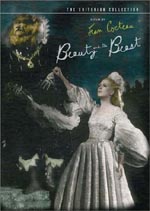
BEAUTY AND THE BEAST (CRITERION COLLECTION)
Reviewed March 5th, 2003 by Dan Jones
Beauty and the Beast is perhaps the most known fable centered on a prince being cursed into a monster, and the woman that fell in love with him who then brings him back to his pervious self. In the U.S. we know the Disney adaptation of this French tale in which there is relatively little to fear about the beast and his place of dwelling seems like a pretty cool place to be, with dancing and singing cups and what not. “Be our guest!”
But, in 1946, a much different adaptation was made of the tale. Directed by Jean Cocteau, this Beauty and the Beast has stark differences from what we are used to, most namely being the much darker, much more evil nature of the Beast as well as his dwelling. No longer is the Beast a character that we doubt would hurt a fly (which more or less is the way Disney portrayed him, focusing more on his looks then his temperament), but he can actually be seen as a danger to anyone who comes near him. His dwelling is a place of evil it seems, everything seems to be alive, the statues, the arms protruding from the wall…this is clearly a disturbing place. Yet, our fair Beauty strives to see the goodness in this misunderstood creature, while the Beast strives to change his own ways to love this Beauty. While it might be darker, the love story that is created is equally beautiful.
Perhaps the most impressive aspect of this film is the cinematography for the time. Cocteau truly visualized the fantasy nature of the film with great visuals and special affects, especially when looking at the Beasts dwellings. Imagery is also highly used, most notably in showing the possible danger of the beast (the smoke rising from his hand in one scene for instance).
Overall, this is an exceptional film, one that most have probably never seen and probably pass off as the same story they’ve already seen, just made 50 years earlier. This is not the case.
Presented in its original 1.33:1 aspect ratio, this is a surprisingly good, newly restored, transfer when considering the age of the film. Being black and white, the richness of the blacks versus the contrast of the whites really show the quality of the transfer; if the blacks are all washed out or contrast is pumped up too high you’re going to be left with a grayscale film. Thankfully here, blacks are rich and deep and contrast seems to be just about perfect. The source used does seem to have some damage problems with the occasional dirt and scratches, but overall this is a generally good transfer. Its not impeccable, but its better then you’ve seen.
In typical Criterion fashion the original 1.0 mono track is what we have available here. The fidelity and range is very limited with dialogue a bit harsh at points, but this is the way Criterion has done it (by not adding their own mix) so there’s really nothing to complain about. Given the limitations of mono, the track sounds decent. English subtitles are included as an option.
Starting off the extras we have two information overload audio commentaries. The first track is from Arthur Knight, a film historian, while the second is from Sir Christopher Frayling, a historian of society and culture. Both describe the parallel between the film and the times, as well as how the story had an effect on French culture. If you’re interested, their coverage is fairly extensive.
Next we have a new opera track by Philip Glass presented in 5.1 Dolby Digital. This is his take on a new score for the film, which seems to, in my opinion, change the mood of the film quite significantly. The track does “sound” great though, especially considering that it’s in 5.1 while the film is in mono.
Next we have a piece on the re-release of the film to theaters in 1995 entitled “Screening at the Majestic.” This basically gives an overview of the film, little more. Next we have an interview with Henri Alekan, the film’s cinematographer (whom died June 15, 2001). This is quite an interesting interview as the cinematography in the film is quite exceptional for the time.
Rounding it out we have a photo gallery, a featurette on the restoration process, and the film’s theatrical trailer. We also have a nice booklet in typical Criterion fashion.
The 1946 film that is Beauty and the Beast is not what you might think it is. The Disney film is not at all a re-make of this film, rather a different take on the same tale. Both films are excellent in their own rights, but as having not experienced this film before receiving this DVD, I must say I was blown away by it. On top of that, the DVD presentation here is top notch, with nicely restored video, serviceable audio, and a nice selection of extras this is another easy Criterion Collection recommendation. Not to be missed by fans of film or fans of the tale that is Beauty and the Beast.
Recommended.
Please help support our site by buying this DVD title
through this link. Thank you
kindly.
|


 Purchase
This DVD Purchase
This DVD
Story / Content

Audio

Video

Extras

|